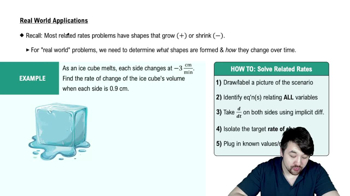Table of contents
- 0. Functions7h 52m
- Introduction to Functions16m
- Piecewise Functions10m
- Properties of Functions9m
- Common Functions1h 8m
- Transformations5m
- Combining Functions27m
- Exponent rules32m
- Exponential Functions28m
- Logarithmic Functions24m
- Properties of Logarithms34m
- Exponential & Logarithmic Equations35m
- Introduction to Trigonometric Functions38m
- Graphs of Trigonometric Functions44m
- Trigonometric Identities47m
- Inverse Trigonometric Functions48m
- 1. Limits and Continuity2h 2m
- 2. Intro to Derivatives1h 33m
- 3. Techniques of Differentiation3h 18m
- 4. Applications of Derivatives2h 38m
- 5. Graphical Applications of Derivatives6h 2m
- 6. Derivatives of Inverse, Exponential, & Logarithmic Functions2h 37m
- 7. Antiderivatives & Indefinite Integrals1h 26m
- 8. Definite Integrals4h 44m
- 9. Graphical Applications of Integrals2h 27m
- 10. Physics Applications of Integrals 2h 22m
4. Applications of Derivatives
Related Rates
Problem 3.11.42
Textbook Question
A 12-ft ladder is leaning against a vertical wall when Jack begins pulling the foot of the ladder away from the wall at a rate of 0.2 ft/s. What is the configuration of the ladder at the instant when the vertical speed of the top of the ladder equals the horizontal speed of the foot of the ladder?
 Verified step by step guidance
Verified step by step guidance1
Start by setting up a coordinate system where the wall is the y-axis and the ground is the x-axis. Let x be the distance from the wall to the foot of the ladder, and y be the height of the ladder on the wall. The ladder forms a right triangle with the wall and the ground.
Use the Pythagorean theorem to relate x and y: x^2 + y^2 = 12^2. This equation represents the constant length of the ladder.
Differentiate both sides of the equation with respect to time t to find the relationship between the rates of change of x and y. This gives: 2x(dx/dt) + 2y(dy/dt) = 0.
Substitute the given rate dx/dt = 0.2 ft/s into the differentiated equation. This will allow you to solve for dy/dt, the rate at which the top of the ladder is moving down the wall.
Set dy/dt equal to dx/dt to find the configuration where the vertical speed of the top of the ladder equals the horizontal speed of the foot of the ladder. Solve the resulting equation for x and y to find the specific configuration of the ladder.
 Verified video answer for a similar problem:
Verified video answer for a similar problem:This video solution was recommended by our tutors as helpful for the problem above
Video duration:
5mPlay a video:
Was this helpful?
Key Concepts
Here are the essential concepts you must grasp in order to answer the question correctly.
Related Rates
Related rates involve finding the rate at which one quantity changes in relation to another. In this problem, the rates of change of the horizontal distance of the ladder's foot from the wall and the vertical height of the ladder's top are interconnected. By applying the chain rule, we can relate these rates to the geometry of the situation.
Recommended video:

Intro To Related Rates
Pythagorean Theorem
The Pythagorean theorem states that in a right triangle, the square of the length of the hypotenuse is equal to the sum of the squares of the lengths of the other two sides. In this scenario, the ladder, the wall, and the ground form a right triangle, where the ladder is the hypotenuse. This relationship is crucial for establishing the relationship between the vertical and horizontal distances.
Recommended video:

Fundamental Theorem of Calculus Part 1
Instantaneous Rate of Change
The instantaneous rate of change refers to how a quantity changes at a specific moment in time. In this context, we are interested in the moment when the vertical speed of the ladder's top equals the horizontal speed of the foot. Understanding this concept allows us to set up equations that can be solved to find the configuration of the ladder at that instant.
Recommended video:

Intro To Related Rates
Related Videos
Related Practice





